
We share places, products and activities we recommend. If you make a purchase using a link on our site, we may earn a commission.
Atrocities, torture and hard labor emerge as the most common images of World War II POW camps. Words like kindness, cooperation and creativity rarely describe these encampments of war-time imprisonment. But the miracle of Camp 60 on Lambholm Island, an uninhabited outcropping of the Orkney Islands, Scotland, proved to be the exception.
From 1943 to present day, the inspiration of 250 Italian POWs captured during the Allied North African campaign, lives on as a historical example with an Italian Chapel in the Orkney Islands.
On a British Isles Adventure to the Scottish OrkFney Islands several years ago, we had the privilege of experiencing this marvel.
Note: Scotland is now open for travelers. Put a visit to the Italian Chapel Orkney on your ‘must do’ list.
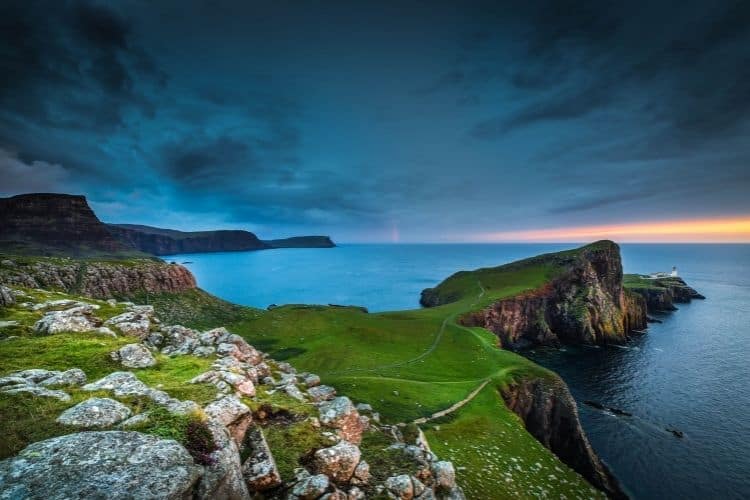
How WWII is Linked to the Italian Chapel in Orkney
On October 13, 1939, a German U-Boat slipped undetected into Scapa Flow, the waterway which fronts Lambholm Island and torpedoed the British battleship Royal Oak, anchored in Scapa Bay.
The loss of the ship and 833 crew members prompted Winston Churchill to order construction of concrete causeways to block access between the island and Mainland Orkney.
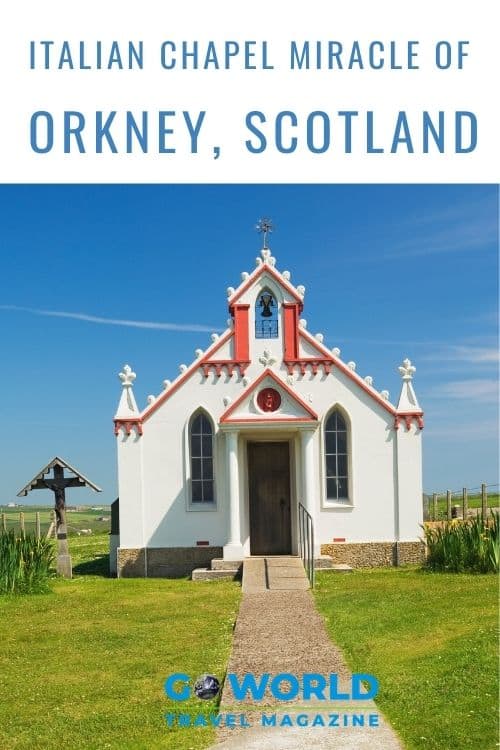
Due to the labor shortage of British workers enlisted in the war effort, The Churchill Barriers as they were called were built by Italian POWs brought to Lambholm for this sole purpose.
To house the Italians, the British constructed 13 gloomy Nissen huts, the UK version of Quonset prefabricated shelters with semicircular arched roofs and concrete floors. The prisoners set about to transform their drab environment.
With surplus building materials, they constructed concrete pathways, a recreation hut, and a cement billiard table and planted wild flowers endemic to the island.
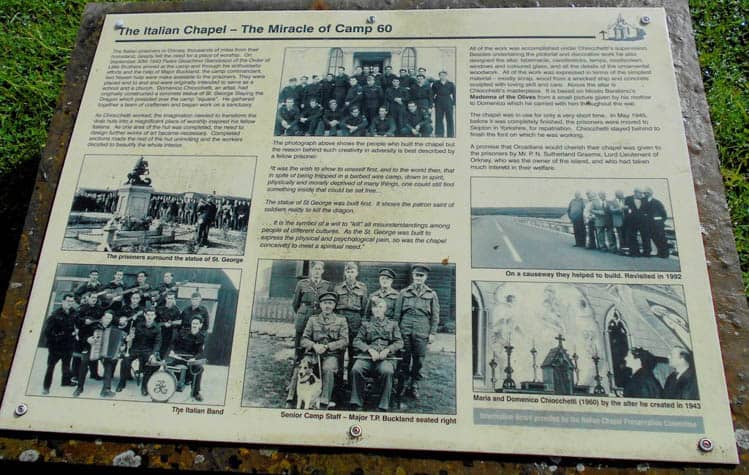
POWs Create a Sanctuary
Prisoner Domenico Chiochetti, an artist by pre-war profession from Moena, Italy, took charge of the beautification project and even constructed an image of St. George out of barbed wire covered with cement. But these faithful Catholics sadly lacked a chapel where they could pray.
A new camp commandant, Major T.P. Buckland, and sympathetic chaplain, Father P. Gioacchino Giacobazzi enlisted the artistic services of Domenico to create a chapel out of two Nissen huts joined end to end.
Chiochetti gathered prisoners, whose professional expertise included a cement worker, a blacksmith, electricians and house painters, to turn a pipedream into reality. After completing their daily required labor on the barriers, the prisoners used their downtime to work on the chapel.
All building materials had to be scavenged from second-hand, worthless scrap and the men dug deep into their imaginations and ingenuity for items that could be salvaged for use. Extra concrete hid the ugly contoured exterior of corrugated iron and transformed the façade with a belfry and ornamental Greek pinnacles into the shape of a tiny church.
The commandant obtained left-over plasterboard to cover the unsightly interior walls, making them suitable for Chiochetti’s magnificent fresco paintings of four evangelists, the Madonna and Christ Child, and the symbol of the Holy Spirit, a White Dove.
Wood from a wrecked ship doubled as the tabernacle. Empty corned beef tins covered in concrete served as light fixture holders and a discarded automobile exhaust pipe dipped in cement molded into the Baptismal font.
Glass windows, on which Chiochetti painted detailed religious stories, substituted for stained glass, and allowed light, the sun’s warmth and hope to stream into the sacred altar area.
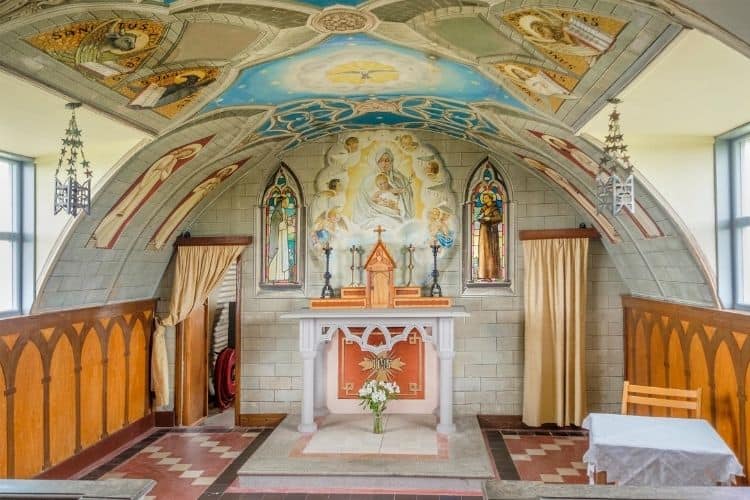
An Artist’s Dedication
When Italy capitulated to the Allies in 1944, the prisoners left the island and returned to their homeland. But, Domenico Chiochetti, so dedicated to the work of this sanctuary which had saved the men from loneliness and despair, remained behind to finish the detailed paintings inside the chapel.
This fact alone speaks to the miracle of the Italian Chapel; a POW who chose to remain in the camp rather than race home to his country and family.
Before his departure, Chiochetti turned the Italian Chapel over to the Orcadians and implored the owner of the island, Mr. Sutherland Graeme, to promise that the people of Orkney would cherish their chapel and maintain it.
After the war all of the camp buildings that served the material needs of the POWs were removed, but the Chapel and the statue of St. George, which had quenched their spiritual needs, remained.
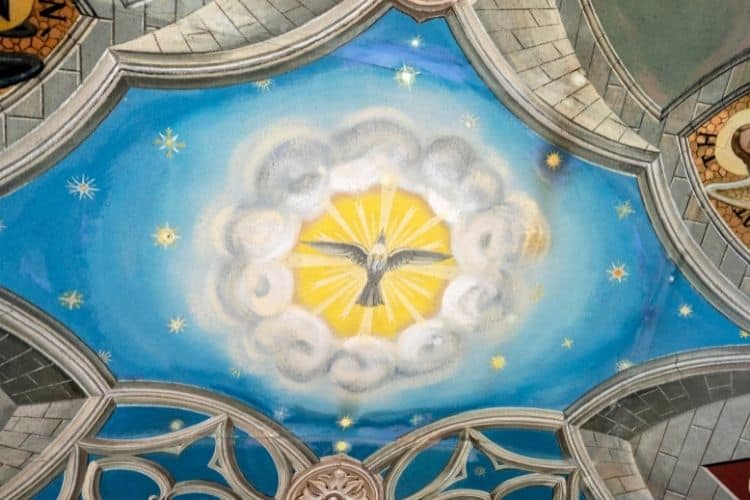
An Italian Chapel That Inspires Thousands
Locals and tourists by the thousands vacationing in the Orkney Islands, Scotland started to make pilgrimages to see the miracle of the little Italian Chapel. Its fame grew through recognition by the BBC and Mr. Graeme formed a local commission to preserve the building.
Funds for restoration and maintenance were entirely covered by a minimal entrance fee charged and from donations left in the coffers by appreciative travelers. Our visit to this physical testament of faith during times of grave adversity 73 years after its inception proved emotional.
Allison Sutherland Graeme, daughter of the original owner of the island and now in her 80’s, arrived at the Chapel during our time there to share her childhood experiences.
Back in 1942, she and her parents lived in a huge farmhouse on the edge of the POW camp. Fascinated by the unusual activity and the strange men stationed just steps from her home, she spent many hours interacting with the prisoners during the construction of their beloved sanctuary.
Allison described lively moments for a 10-year old girl with her stories of the men’s dedication to their faith. Her memories made the prisoner’s work on the chapel come alive for me. Allison relived for us the events that have occurred at the Chapel over the course of the past half century.
In 1960, as a guest of the Chapel Preservation Committee and the BBC, Domenico Chiochetti returned to Lambholm. He spent three weeks restoring the faded religious wall paintings he had initially created. Mass was held during his visit and he was the first person to receive the Holy Sacrament in the Chapel.
In 1992, a gathering of eight of the original POWs returned to celebrate the 50th anniversary of their enlightened encampment. Domenico’s health prevented him from making the journey, but the entire service was broadcast by Italian National Radio so the residents of Moena could celebrate from afar.
Check out this article on the Top 10 Things to do in Scotland

The Little Italian Chapel Today
Today, the Italian Chapel on Lambholm Island remains under the auspices of the Roman Catholic Parish of Our Lady and St. Joseph Diocese of Aberdeen, Scotland.
Mass is held in the Chapel on the first Sunday of the summer months, April through September. Over 100,000 tourists visit the Chapel each year and it is considered to be the best known ‘symbol of reconciliation in the British Isles. A loving relationship remains between the people of Orkney and the families of the original POWs.
For me, in these present times of difficulties throughout the globe and struggles to return to the love and wonderment of travel, The Italian Chapel on Lambholm Island, Orkney, Scotland represents an icon of cohesiveness, optimism and hope.
Perhaps someday our world will return to an atmosphere where even Prisoners of War have the opportunity to be treated with respect and to exercise creativity, practice their religion and develop life-long friendships with people who were once their enemies.
Historical facts obtained from the Chapel Preservation Committee Booklet, Orkney’s Italian Chapel; www.orkneycommunities.co.uk/italianchapel
Book This Trip
Start planning your exciting journey through history on the Orkney Islands today! Find exclusive flight deals and ground transportation packages here through Kiwi. Next, you can get prepared to travel by checking out hotel and VRBO options, favorite Scottish restaurants and insider tips on how to get around through Travelocity and TripAdvisor.
See all that you can of the Orkney Islands by booking some tours and day trips here.
Author’s Bio: After a life-long profession of treating the mentally ill at a PA psychiatric hospital for 33 years and also serving as its Director of Admissions, Carol L. Bowman retired to Lake Chapala, Mexico in 2006 with her husband, to pursue more positive passions. Her family thought that she, too, had ‘gone mad.’ She’s been teaching English to Mexican adults for ten years, in a program operated by volunteer expatriates and writing for local online and print publications. Using her adventures experienced during visits to over 80 countries to capture a niche in travel writing, Carol also dabbles in ‘memoir.’ A frequent contributor to Lake Chapala English magazine, “El Ojo del Lago,” she’s won several literary awards from that publication, including Best Feature in 2010 and Best Fiction in 2014. She also netted a story regarding her psychiatric fieldwork in the published anthology, “Tales from the Couch.”
- Exploring the Culture and History in Fascinating Astana, Kazakhstan - July 24, 2024
- Breakers & Beyond: Top 10 Things To Do in Newport, Rhode Island - July 23, 2024
- Laid-Back Lombok: Coconut, Coffee and Coral Reefs - July 22, 2024
